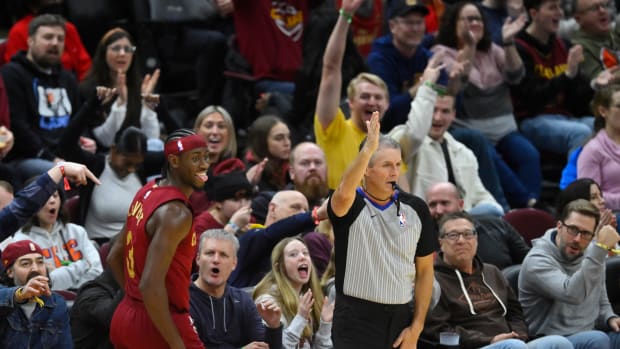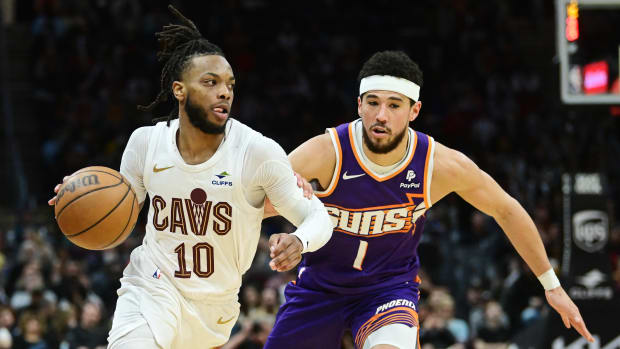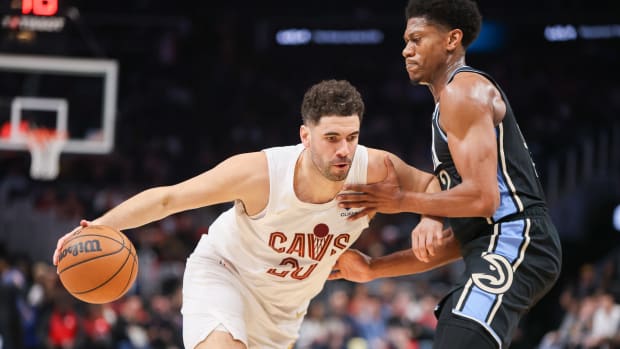
Alfes: Bucks guard Brown holding down fort for Brogdon
The Milwaukee Bucks have trotted out 11 different starting lineups without the injured Malcolm Brogdon this season, the latest of which included Giannis Antetokounmpo, Eric Bledsoe, Khris Middleton, Sterling Brown and Brook Lopez in Game 1 of the Eastern Conference quarterfinals.
That lineup is a perfect 5-0 -- and it might have something to do with Brogdon’s replacement.
Brown -- the brother of two-time champion Shannon Brown -- led Milwaukee with a +38 in Sunday’s blowout win over the Pistons, a comprehensive effort of 11 points, seven assists, three rebounds, three steals and a block on 3-of-5 shooting from 3-point range. Brogdon could return in the semifinal round, but Brown has made that much less of an urgent matter.
The 6-foot-6, 24-year-old shooting guard has transformed his game from year one to year two in the NBA.
In his rookie season, Brown had little variance on the offensive side of the ball. Head coaches Jason Kidd and Joe Prunty tucked him into the corner, where he attempted 44% of his three-point shots. He also took zero dribbles on 53.3% of his two-point attempts and 44% of his three-point attempts.
Simply put -- there wasn’t much opportunity for Brown to show what he could do with the ball.
Brown’s location on the court also made it difficult for him to pass the ball, as evidenced by his 0.5 assists per game and 4.5% assist rate. For a player that averaged three assists per game at Southern Methodist University -- Kidd and Prunty were minimizing Brown’s impact rather than maximizing his abilities.
Current head coach Mike Budenholzer has turned Brown's career around.
Budenholzer’s system has allowed a more assertive Brown to thrive, especially when Brogdon, Tony Snell and Nikola Mirotic were on the mend throughout the second half of the season. Brown plays more freely through his penetration, distribution and overall efficiency.
Take this highlight against the Hawks on March 31, where Brown uses his quickness to pass an overmatched John Collins in isolation…
Or this breakaway jam just one week later, where Brown attacks the rim at full force in transition…
Brown is finding new ways to score -- and the numbers from last season to this season justify that notion…
Part of Brown’s success stems from opportunity, as Budenholzer gave him an average of 23 minutes per game in March and 30 minutes per game in April. Part of Brown’s success also stems from those around him, as Antetokounmpo is an MVP candidate, Middleton landed his first All-Star Game selection, Bledsoe had a career-high effective field goal percentage and Lopez is now a legitimate three-point threat. As the fifth option in the starting five, Brown’s opportunities occasionally come on open shots and uncontested lanes to the hoop.
Regardless, Brown has still filled a void that many thought would cost the Bucks’ hopes of making a deep playoff run. No longer is he settling for three-pointers in the corner, where he now only takes 37.4% of his three-point attempts. No longer is he an afterthought of an option.
Compared to last season, Brown raised his field goal percentage from 40% to 46%, his two-point field goal percentage from 43.9% to 55.8% and his three-point field goal percentage from 35.2% to 36.1%. His assist numbers elevated from 0.5 to 1.4, too, and a seven-assist performance vs. Detroit on Sunday furthered that encouraging trend.
The defensive numbers are just as effective, too. Brown doubled his defensive win shares from 0.7 to 1.4 despite only playing 258 more minutes from 2017-18 to 2018-19. His three-steal, one-block performance on Sunday also furthered that encouraging trend.
When Brogdon went down, the Bucks didn’t need a player to match his production -- but they did need someone to hold down the fort.
Sterling Brown has been the answer, becoming a multi-dimensional player and an asset to the Milwaukee organization along the way.





